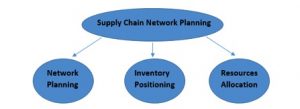Li Liang, email at lli91@vt.edu
Supply chain network can be large and sophisticated, since it can involve many individual companies and many different processes and activities. Supply chain network planning is also very sophisticated, since it needs to cooperate those different individual companies and integrate many different processes and activities in the supply chain network in order to improve the value of products or minimize the system-wide costs but still satisfy the demand of customer with a good level (Che and Sha 2006). It is easy to say that the supply chain network planning can minimize cost and still maintain a good service level, but to actually achieve them both, it needs a lot of effort. Take a very straightforward example. It exists an obvious tradeoff between these two objectives, that is, if the supply chain needs to maintain a high service level, its system-wide cost will definitely increase, or if the supply chain needs to minimize its system-wide cost, the service level needs to give way. It seems that balancing the tradeoff is an art in supply chain network planning. Simchi-Levi et al (2008) stated that Supply chain network planning can help companies to:
- Balance the cost trade off among inventory, transportation, and manufacturing.
- Balance supply and demand under uncertainty through effective inventory management and positioning
- Balance the available recourses to select the most appropriate product sourcing facilities.

Associated with the above advantages, supply chain network planning can be divided in three steps as shown in Figure 1: planning, positioning and allocation. According to Simchi-Levi et al (2008), network design provides a physical configuration and infrastructure for supply chain. To achieve this objective, the data about locations of each facilities (suppliers, production plants, warehouses, distribution centers, retailers and even customers), all product information, annual demand, costs of each supply chain activities, and customer service requirements need to be collected first. After that, this huge amount of original data need to be aggregated to reduce the variance and for further utilization. The aggregated data would then be used to estimate transportation rates, mileage between two locations, warehouse costs, warehouse size, warehouse locations, service level, and future demand. The estimated data would be used to construct the supply chain network model, then both model and the estimated data would be validated by comparing the output of model with the existing data. After the validation, the model can be optimized by using mathematical optimization techniques or simulation model.
Inventory positioning is very difficult because it needs to determine the inventory control mechanism for each form of inventory (raw material inventory, work-in-process inventory, and finished product inventory), which needs to consider a lot of information. Such as production cost, distribution cost, inventory management cost, and even service level. There exist a lot of approaches for inventory management, such as (Q, R) policy, base-stock policy or critical fractile. The (Q, R) policy refers to calculate the optimal order quantity Q and reorder point R, and then place the order with a quantity of Q when inventory level reach the reorder point. The base-stock policy refers to calculate the base stock level and safety stock, when inventory level reach the safety stock level, it order up to the base stock level. The critical fractile refers to using the overage cost and underage cost to determine the optimal order quantity. Usually, the cumulative distribution function of the demand equals to the coverage cost divided by the sum of overage cost and underage cost.
Resource allocation can be done by using supply chain master planning. Master planning coordinates flows between each site and try to find the most effective way to meet demand forecast in a season cycle. It can maximize the profit or minimize the cost by balancing the demand forecasts with different capacities, and allocating production quantities to different sites to avoid bottlenecks (Stadtler 2005).
Planning the supply chain network is a very complex process but important, it involves in a set of strategic level decisions that would impact a supply chain’s future overall performance (Bahazadeh 2016). Planning of the supply network through these three steps can provide a company with a solid foundation, a better starting point, and further globally optimize supply chain performance
References:
- Babazadeh, R. (2016). Optimal design and planning of biodiesel supply chain considering non-edible feedstock. Renewable and Sustainable Energy Reviews, available online 15 November 2016
- Simchi-Levi, D., Simchi-Levi, E., & Kaminsky, P. Shankar, R. (2008). Designing and managing the supply chain: Concepts, strategies, and case studies 3rd edition. New York: McGraw-Hill.
- Sha, D.Y., Che, Z.H. (2006). Supply china network design: partner selection and production/distribution planning using a systematic model. Journal of the operational research society. 57 (1) 52-62
- Stadtler, H. (2006). Supply chain management and advanced planning—basics, overview and challenges. European Journal of Operational Research. 163 (3) 575-588
